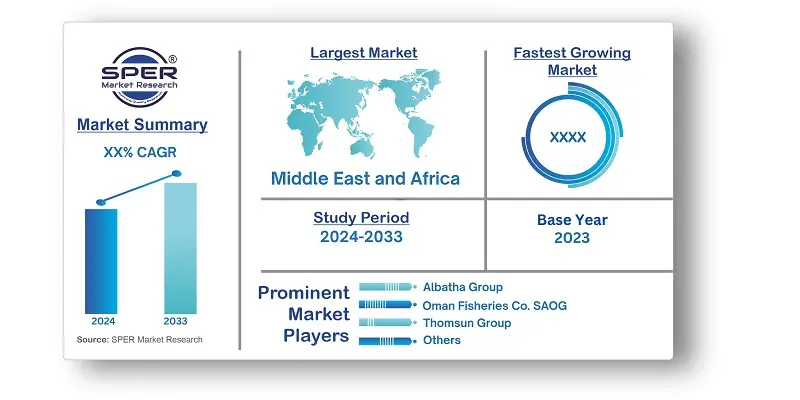
Middle East and Africa Seafood Market Trends, Share, Demand, Competition and Future Outlook
Middle East and Africa Seafood Market Growth, Size, Trends Analysis- By Type, By Form, By Distribution Channel- Regional Outlook, Competitive Strategies and Segment Forecast to 2033
| Published: Nov-2024 | Report ID: FOOD24130 | Pages: 1 - 156 | Formats*: |
| Category : Food & Beverages | |||
- Gulf Japan Food Fund has made an investment in Oman Fisheries Co. SAOG as of May 2022. As a result, Oman Fisheries was able to increase its presence in international markets.
- In February 2022, Asmak and Fish Farm, an aquaculture company based in the United Arab Emirates, announced a strategic distribution deal. In accordance with this arrangement, Asmak uses its processing facility and robust distribution channels—including wholesale, restaurant, and retail—to market fish farm products in order to reach a larger audience both locally and regionally.


| Report Metric | Details |
| Market size available for years | 2020-2033 |
| Base year considered | 2023 |
| Forecast period | 2024-2033 |
| Segments covered | By Type, By Form, By Distribution Channel. |
| Regions covered | Qatar, Saudi Arabia, United Arab Emirates, Egypt, Morocco, Nigeria, South Africa, Rest of Middle-East and Africa. |
| Companies Covered | Albatha Group, Almunajem Foods, Blue Island PLC, Enhance Group Holding Company Limited, National Fishing Company K.S.C., Oman Fisheries Co. SAOG, Sea Pride LLC, The Deep Seafood Company, Thomsun Group, Yamama Al-Baida Gen. Trading & Cont. Est., Others. |
- Government and Regulatory Authorities
- Solar Power Developers and EPC Contractors
- Investors and Financial Institutions
- Solar Panel Manufacturers and Suppliers
- Utility Companies and Energy Providers
- Commercial and Industrial Enterprises
- Residential Consumers
- Research and Development Organizations
| By Type: | |
| By Form: | |
| By Distribution Channel: |
- Middle East and Africa Seafood Market Size (FY’2024-FY’2033)
- Overview of Middle East and Africa Seafood Market
- Segmentation of Middle East and Africa Seafood Market By Type (Fish, Shrimp, Others)
- Segmentation of Middle East and Africa Seafood Market By Form (Canned, Fresh/ Chilled, Frozen, Processed)
- Segmentation of Middle East and Africa Seafood Market By Distribution Channel (Off-Trade, On-Trade)
- Expansion Analysis of Middle East and Africa Seafood Market
- Problems and Obstacles in Middle East and Africa Seafood Market
- Competitive Landscape in the Middle East and Africa Seafood Market
- Impact of COVID-19 and Demonetization on Middle East and Africa Seafood Market
- Details on Current Investment in Middle East and Africa Seafood Market
- Competitive Analysis of Middle East and Africa Seafood Market
- Prominent Players in the Middle East and Africa Seafood Market
- SWOT Analysis of Middle East and Africa Seafood Market
- Middle East and Africa Seafood Market Future Outlook and Projections (FY’2024-FY’2033)
- Recommendations from Analyst
1.1. Scope of the report1.2. Market segment analysis
2.1. Research data source
2.1.1. Secondary Data2.1.2. Primary Data2.1.3. SPER’s internal database2.1.4. Premium insight from KOL’s
2.2. Market size estimation
2.2.1. Top-down and Bottom-up approach
2.3. Data triangulation
4.1. Driver, Restraint, Opportunity and Challenges analysis
4.1.1. Drivers4.1.2. Restraints4.1.3. Opportunities4.1.4. Challenges
4.2. COVID-19 Impacts of the Middle East and Africa Seafood Market
5.1. SWOT Analysis
5.1.1. Strengths5.1.2. Weaknesses5.1.3. Opportunities5.1.4. Threats
5.2. PESTEL Analysis
5.2.1. Political Landscape5.2.2. Economic Landscape5.2.3. Social Landscape5.2.4. Technological Landscape5.2.5. Environmental Landscape5.2.6. Legal Landscape
5.3. PORTER’s Five Forces
5.3.1. Bargaining power of suppliers5.3.2. Bargaining power of buyers5.3.3. Threat of Substitute5.3.4. Threat of new entrant5.3.5. Competitive rivalry
5.4. Heat Map Analysis
6.1. Middle East and Africa Seafood Market Manufacturing Base Distribution, Sales Area, Product Type6.2. Mergers & Acquisitions, Partnerships, Product Launch, and Collaboration in Middle East and Africa Seafood Market
7.1. Middle East and Africa Seafood Market Size, Share and Forecast, By Type, 2020-20267.2. Middle East and Africa Seafood Market Size, Share and Forecast, By Type, 2027-20337.3. Fish7.4. Shrimp7.5. Others
8.1. Middle East and Africa Seafood Market Size, Share and Forecast, By Form, 2020-20268.2. Middle East and Africa Seafood Market Size, Share and Forecast, By Form, 2027-20338.3. Canned8.4. Fresh/ Chilled8.5. Frozen8.6. Processed
9.1. Middle East and Africa Seafood Market Size, Share and Forecast, By Distribution Channel, 2020-20269.2. Middle East and Africa Seafood Market Size, Share and Forecast, By Distribution Channel, 2027-20339.3. Off-Trade9.4. On-Trade
10.1. Middle East and Africa Seafood Market Size and Market Share
11.1. Middle East and Africa Seafood Market Size and Market Share By Region (2020-2026)11.2. Middle East and Africa Seafood Market Size and Market Share By Region (2027-2033)11.3. Qatar11.4. Saudi Arabia11.5. United Arab Emirates11.6. Egypt11.7. Morocco11.8. Nigeria11.9. South Africa11.10. Rest of Middle-East and Africa
12.1. Albatha Group
12.1.1. Company details12.1.2. Financial outlook12.1.3. Product summary12.1.4. Recent developments
12.2. Almunajem Foods
12.2.1. Company details12.2.2. Financial outlook12.2.3. Product summary12.2.4. Recent developments
12.3. Blue Island PLC
12.3.1. Company details12.3.2. Financial outlook12.3.3. Product summary12.3.4. Recent developments
12.4. Enhance Group Holding Company Limited
12.4.1. Company details12.4.2. Financial outlook12.4.3. Product summary12.4.4. Recent developments
12.5. National Fishing Company K.S.C.
12.5.1. Company details12.5.2. Financial outlook12.5.3. Product summary12.5.4. Recent developments
12.6. Oman Fisheries Co. SAOG
12.6.1. Company details12.6.2. Financial outlook12.6.3. Product summary12.6.4. Recent developments
12.7. Sea Pride LLC
12.7.1. Company details12.7.2. Financial outlook12.7.3. Product summary12.7.4. Recent developments
12.8. The Deep Seafood Company
12.8.1. Company details12.8.2. Financial outlook12.8.3. Product summary12.8.4. Recent developments
12.9. Thomsun Group
12.9.1. Company details12.9.2. Financial outlook12.9.3. Product summary12.9.4. Recent developments
12.10. Yamama Al-Baida Gen. Trading & Cont. Est.
12.10.1. Company details12.10.2. Financial outlook12.10.3. Product summary12.10.4. Recent developments
12.11. Others
SPER Market Research’s methodology uses great emphasis on primary research to ensure that the market intelligence insights are up to date, reliable and accurate. Primary interviews are done with players involved in each phase of a supply chain to analyze the market forecasting. The secondary research method is used to help you fully understand how the future markets and the spending patterns look likes.
The report is based on in-depth qualitative and quantitative analysis of the Product Market. The quantitative analysis involves the application of various projection and sampling techniques. The qualitative analysis involves primary interviews, surveys, and vendor briefings. The data gathered as a result of these processes are validated through experts opinion. Our research methodology entails an ideal mixture of primary and secondary initiatives.



Frequently Asked Questions About This Report
PLACE AN ORDER
Year End Discount
Sample Report
Pre-Purchase Inquiry
NEED CUSTOMIZATION?
Request CustomizationCALL OR EMAIL US
100% Secure Payment






Related Reports
Our Global Clients
Our data-driven insights have influenced the strategy of 200+ reputed companies across the globe.






















